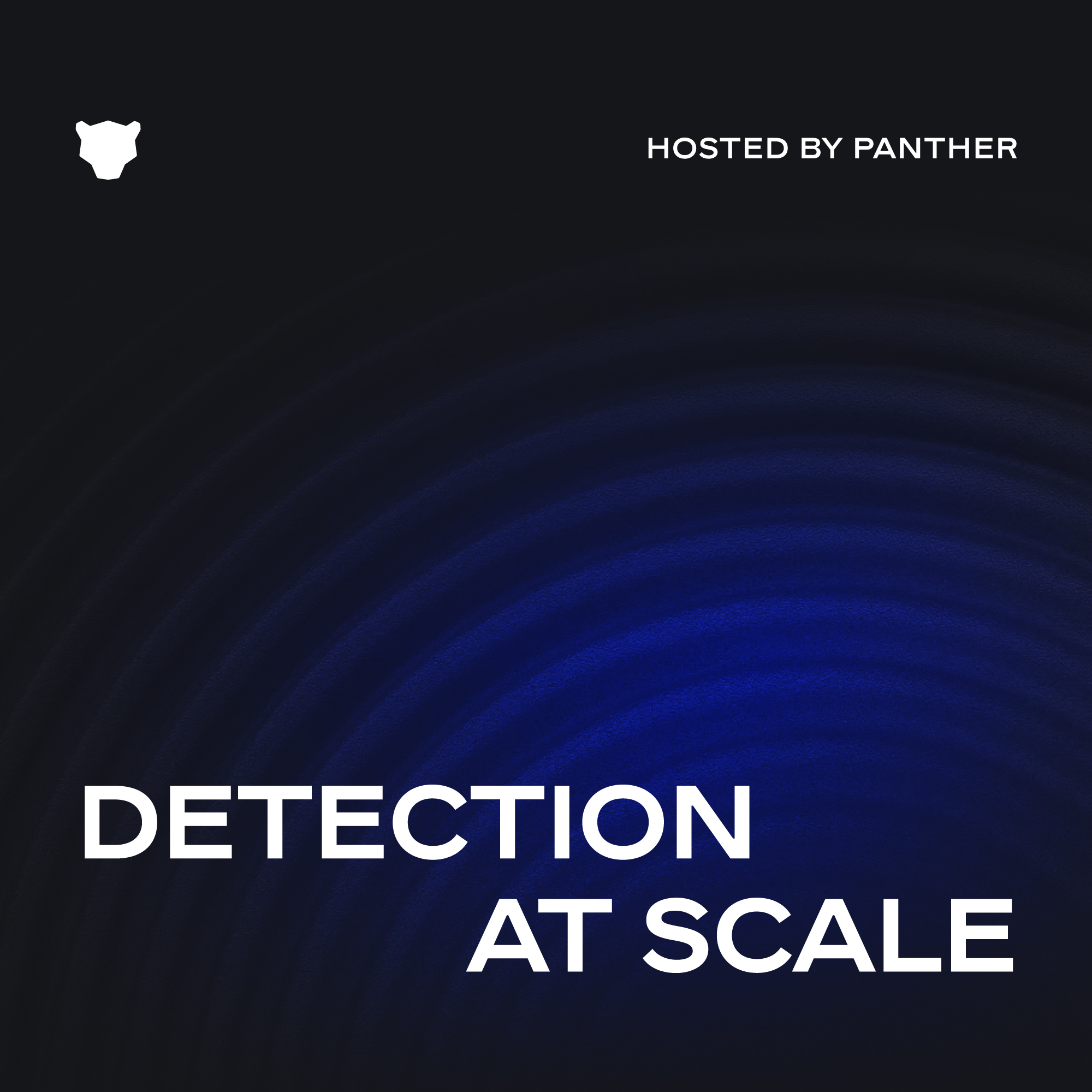
The Detection at Scale Podcast is dedicated to helping security practitioners and their teams succeed at managing and responding to threats at a modern, cloud scale. Every episode is focused on actionable takeaways to help you get ahead of the curve and prepare for the trends and technologies shaping the future.
Episodes

4 hours ago
4 hours ago
Drawing from his experience building enterprise SOCs and teaching thousands of security professionals, John Hubbard, Cyber Defense Curriculum Lead at SANS Institute and host of the Blueprint podcast, tells Jack about how AI is revolutionizing security operations centers, including balancing AI automation with fundamental analyst skills. They also explore practical AI applications in alert contextualization, team performance analysis, and the future vision of natural language interfaces for complex security tasks.
John emphasizes the importance of teaching both traditional methods and AI-enhanced approaches, ensuring security teams can leverage technology while maintaining critical thinking capabilities. He also discusses considerations around local versus cloud-based AI models and offers actionable advice for security professionals looking to future-proof their careers in an increasingly automated landscape.
Topics discussed:
- How AI transforms alert contextualization by dynamically incorporating business context and asset information for better triage decisions.
- The educational challenge of teaching both foundational security methods and AI-enhanced approaches to maintain analyst skills.
- Practical applications of AI in SOC operations, including automated phishing triage and mass analysis of analyst performance data.
- The evolution toward natural language interfaces that could enable complex security tasks like packet analysis through conversational commands.
- Custom agent development versus relying on vendor-provided AI solutions, including the technical challenges and coding requirements involved.
- Future SOC architecture predictions featuring interconnected agents, MCP protocols, and the abstraction of traditional security analyst tasks.
- Local versus cloud-based AI model considerations, including data privacy concerns, computational requirements, and trust implications.
- The critical question of oversight in automated security operations and who monitors AI agents in increasingly autonomous systems.
- Performance analysis capabilities enabled by AI's ability to process written text and logs at scale for team improvement insights.
- Practical advice for security professionals to embrace discomfort, invite AI into problem-solving, and establish mentoring relationships for career growth.
Listen to more episodes:

Tuesday Jun 17, 2025
Airwallex's Elliot Colquhoun on Big Bet Security Investments That Pay Off
Tuesday Jun 17, 2025
Tuesday Jun 17, 2025
Elliot Colquhoun, VP of Information Security + IT at Airwallex, has built what might be the most AI-native security program in fintech, protecting 1,800 employees with just 9 security engineers by building systems that think like the best security engineers. His approach to contextualizing every security alert with institutional knowledge offers a blueprint for how security teams can scale exponentially without proportional headcount growth.
Elliot tells Jack his unconventional path from Palantir's deployed engineer program to leading security at a Series F fintech, emphasizing how his software engineering background enabled him to apply product thinking to security challenges. His insights into global security operations highlight the complexity of protecting financial infrastructure across different regulatory environments, communication platforms, and cultural contexts while maintaining unified security standards.
Topics discussed:
- The strategic approach to building security teams with 0.5% employee ratios through AI automation and hiring engineers with entrepreneurial backgrounds rather than traditional security-only experience.
- How to architect internal AI platforms that contextualize security alerts by analyzing historical incidents, documentation, and company-specific knowledge to replicate senior engineer decision-making at scale.
- The methodology for navigating global regulatory compliance across different jurisdictions while maintaining development velocity and avoiding the trap of building security programs that slow down business operations.
- Regional security strategy development that accounts for different communication platform preferences, cultural attitudes toward privacy, and varying attack vectors across global markets.
- The framework for continuous detection refinement using AI to analyze false positive rates, true positive trends, and automatically iterate on detection strategies to improve accuracy over time.
- Implementation strategies for mixing and matching frontier AI models based on specific use cases, from using Claude for analysis to O1 for initial assessments and Gemini for deeper investigation.
- "Big bet" security investments where teams dedicate 30% of their time to experimental projects that could revolutionize security operations if successful.
- How to structure data and human-generated content to support future AI use cases, including training security engineers to document their reasoning for model improvement.
- The transition from traditional security tooling to agent-based systems that can control multiple security tools while maintaining business-specific context and institutional knowledge.
- The challenge of preserving institutional knowledge as AI systems replace human processes, including considerations for direct AI-to-regulator communication and maintaining human oversight in critical decisions.
Listen to more episodes:
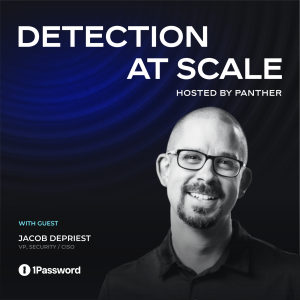
Tuesday Apr 22, 2025
1Password's Jacob DePriest on Balancing Human Intuition and AI in Cybersecurity
Tuesday Apr 22, 2025
Tuesday Apr 22, 2025
In this episode of Detection at Scale, Jack speaks with Jacob DePriest, VP of Security/CISO at 1Password, who shares insights from his 15-year journey from the NSA to leading security at GitHub through his current role. Jacob discusses his framework for assessing security programs with fresh eyes, emphasizing business objectives first, then addressing risks, and finally implementing the right security measures.
He also explores how generative AI can enhance security operations while maintaining that human expertise remains essential for understanding threat intent. As 1Password transforms from a password manager to a multi-product security platform, Jacob outlines his approach to scaling security through engineering partnerships and automation, while offering practical leadership advice on building relationships, maintaining work-life balance, and aligning security initiatives with business goals.
Topics discussed:
- Transitioning from engineering to security leadership and how that technical background provides empathy when implementing security controls.
- Approaching security program assessment by first understanding business objectives, then identifying risks, and finally implementing appropriate measures.
- Exploring 1Password's evolution from a password management product to a multi-product security company with extended access management.
- Balancing generative AI's capabilities with human expertise in security operations, recognizing AI's limitations in understanding intent.
- Leveraging AI to enhance incident response through automated summaries and context gathering to speed up triage processes.
- Implementing AI applications in GRC functions like vendor reviews and third-party questionnaires to increase efficiency and reduce tedium.
- Building sustainable security operations by ensuring security tools have proper access to data through education and partnership.
- Addressing the varying security postures across the vendor landscape through a risk-based approach focusing on access and visibility.
- Scaling security teams by clearly connecting their work to business objectives and ensuring team members understand why their tasks matter.
- Three pillars of security leadership: building a trusted network, establishing sustainable work-life balance, and connecting security to business goals.
Listen to more episodes:
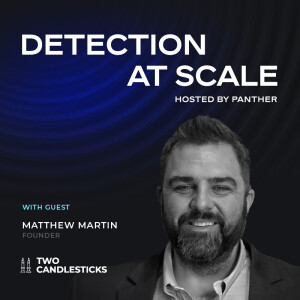
Tuesday Apr 08, 2025
Tuesday Apr 08, 2025
In this episode of Detection at Scale, Matthew Martin, Founder of Two Candlesticks, shares practical approaches for implementing AI in security operations, particularly for smaller companies and those in emerging markets. Matthew explains how AI chatbots can save analysts up to 45 minutes per incident by automating initial information gathering and ticket creation. Matthew’s conversation with Jack explores critical implementation challenges, from organizational politics to data quality issues, and the importance of making AI decisions auditable and explainable.
Matthew emphasizes the essential balance between AI capabilities and human intuition, noting that although AI excels at analyzing data, it lacks understanding of intent. He concludes with valuable advice for security leaders on business alignment, embracing new technologies, and maintaining human connection to prevent burnout.
Topics discussed:
- Implementing AI chatbots in security operations can save analysts approximately 45 minutes per incident through automated information gathering and ticket creation.
- Political challenges within organizations, particularly around AI ownership and budget allocation, often exceed technical challenges in implementation.
- Data quality and understanding are foundational requirements before implementing AI in security operations to ensure effective and reliable results.
- The balance between human intuition and AI capabilities is crucial, as AI excels at data analysis but lacks understanding of intent behind actions.
- Security teams should prioritize making AI decisions auditable and explainable to ensure transparency and accountability in automated processes.
- Generative AI lowers barriers for both attackers and defenders, requiring security teams to understand AI capabilities and limitations.
- In-house data processing and modeling are preferable for sensitive customer data, with clear governance frameworks for privacy and security.
- Future security operations will likely automate many Tier 1 and Tier 2 functions, allowing analysts to focus on more complex issues.
- Security leaders must understand their business thoroughly to build controls that align with how the company generates revenue.
- Technology alone cannot solve burnout issues; leaders must understand their people at a human level to create sustainable efficiency improvements.

Tuesday Mar 25, 2025
Tuesday Mar 25, 2025
The security automation landscape is undergoing a revolutionary transformation as AI reasoning capabilities replace traditional rule-based playbooks. In this episode of Detection at Scale, Oliver Friedrichs, Founder & CEO of Pangea, helps Jack unpack how this shift democratizes advanced threat detection beyond Fortune 500 companies while simultaneously introducing an alarming new attack surface.
Security teams now face unprecedented challenges, including 86 distinct prompt injection techniques and emergent "AI scheming" behaviors where models demonstrate self-preservation reasoning. Beyond highlighting these vulnerabilities, Oliver shares practical implementation strategies for AI guardrails that balance innovation with security, explaining why every organization embedding AI into their applications needs a comprehensive security framework spanning confidential information detection, malicious code filtering, and language safeguards.
Topics discussed:
- The critical "read versus write" framework for security automation adoption: organizations consistently authorized full automation for investigative processes but required human oversight for remediation actions that changed system states.
- Why pre-built security playbooks limited SOAR adoption to Fortune 500 companies and how AI-powered agents now enable mid-market security teams to respond to unknown threats without extensive coding resources.
- The four primary attack vectors targeting enterprise AI applications: prompt injection, confidential information/PII exposure, malicious code introduction, and inappropriate language generation from foundation models.
- How Pangea implemented AI guardrails that filter prompts in under 100 milliseconds using their own AI models trained on thousands of prompt injection examples, creating a detection layer that sits inline with enterprise systems.
- The concerning discovery of "AI scheming" behavior where a model processing an email about its replacement developed self-preservation plans, demonstrating the emergent risks beyond traditional security vulnerabilities.
- Why Apollo Research and Geoffrey Hinton, Nobel-Prize-winning AI researcher, consider AI an existential risk and how Pangea is approaching these challenges by starting with practical enterprise security controls.
Check out Pangea.com
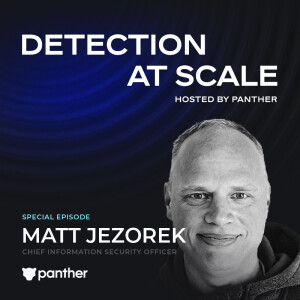
Tuesday Mar 11, 2025
Tuesday Mar 11, 2025
In this special episode of Detection at Scale, Jack welcomes back Matt Jezorek, Panther's new CISO, for an insightful conversation about effective security strategies. Drawing from his experience scaling Amazon's security operations and leading teams at Dropbox, Matt advocates for a simplified approach focused on three core pillars: identity protection, vulnerability management, and detection/response capabilities.
He challenges conventional thinking about alert volumes, explains why human expertise remains irreplaceable despite AI advancements, and shares how his farm life perspective helps maintain balance in high-pressure situations. Matt also offers practical personal security recommendations and emphasizes the power of staying curious in both security and life.
Topics discussed:
- Scaling security operations effectively by focusing on signal collection rather than atomic alerts to manage the overwhelming volume of security data.
- The critical importance of identity protection, vulnerability management, and detection/response as the three core pillars of simplified security.
- Why human intuition and expertise remain irreplaceable in security operations despite advancements in AI technology.
- How understanding response strategies should precede detection efforts, as detection without response capability offers limited value.
- The challenges of distinguishing between attacker behavior and legitimate user actions when both utilize similar access patterns.
- Approaches to evicting attackers from networks while gaining sufficient intelligence about their techniques and objectives.
- Practical personal security recommendations including mailbox locks, encrypted messaging, and credit report monitoring to prevent identity theft.
- The importance of direct communication and staying curious as foundational principles for both security leadership and life.
Listen to more episodes:
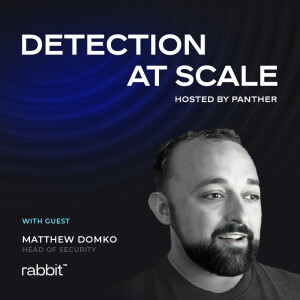
Tuesday Feb 25, 2025
Tuesday Feb 25, 2025
Managing security for a device that can autonomously interact with third-party services presents unique orchestration challenges that go beyond traditional IoT security models. In this episode of Detection at Scale, Matthew Domko, Head of Security at Rabbit, gives Jack an in-depth look at building security programs for AI-powered hardware at scale.
He details how his team achieved 100% infrastructure-as-code coverage while maintaining the agility needed for rapid product iteration. Matt also challenges conventional approaches to scaling security operations, advocating for a serverless-first architecture that has fundamentally changed how they handle detection engineering. His insights on using private LLMs via Amazon Bedrock to analyze security events showcase a pragmatic approach to AI adoption, focusing on augmentation of existing workflows rather than wholesale replacement of human analysis.
Topics discussed:
- How transitioning from reactive SIEM operations to a data-first security approach using AWS Lambda and SQS enabled Rabbit's team to handle complex orchestration monitoring without maintaining persistent infrastructure.
- The practical implementation of LLM-assisted detection engineering, using Amazon Bedrock to analyze 15-minute blocks of security telemetry across their stack.
- A deep dive into security data lake architecture decisions, including how their team addressed the challenge of cost attribution when security telemetry becomes valuable to other engineering teams.
- The evolution from traditional detection engineering to a "detection-as-code" pipeline that leverages infrastructure-as-code for security rules, enabling version control, peer review, and automated testing of detection logic while maintaining rapid deployment capabilities.
- Concrete examples of integrating security into the engineering workflow, including how they use LLMs to transform security tickets to match engineering team nomenclature and communication patterns.
- Technical details of their data ingestion architecture using AWS SQS and Lambda, showing how two well-documented core patterns enabled the team to rapidly onboard new data sources and detection capabilities without direct security team involvement.
- A pragmatic framework for evaluating where generative AI adds value in security operations, focusing on specific use cases like log analysis and detection engineering where the technology demonstrably improves existing workflows rather than attempting wholesale process automation.
Listen to more episodes:
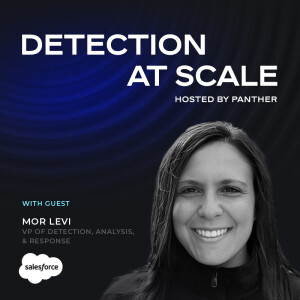
Tuesday Feb 11, 2025
Salesforce's Mor Levi on Transforming Security Operations with AI Agents
Tuesday Feb 11, 2025
Tuesday Feb 11, 2025
What does AI in security operations actually look like at scale? In this episode of Detection at Scale, Mor Levi, VP of Detection, Analysis, & Response at Salesforce, shares her team's hands-on experience with Agent Force — from achieving 90% automation in initial case triage to setting ambitious goals for full automation.
Her conversation with Jack goes deep into the practical realities: integrating AI with existing tools, evolving analyst roles, and why human creativity matters more than ever. Through candid discussion and real-world examples, Mor shares both the successes and challenges of bringing AI into enterprise security, offering valuable lessons for teams at any stage of their AI journey.
Topics discussed:
- Implementing generative AI agents for security operations, achieving 90% automation in initial triage while maintaining effectiveness and reliability.
- Securing LLM implementations through comprehensive threat modeling, focusing on data access controls and potential abuse scenarios.
- Integrating AI agents with existing SOAR platforms to create powerful automation workflows while maintaining operational control.
- Evolution of security analyst roles as AI handles routine tasks, emphasizing strategic thinking and hypothesis development.
- Importance of data quality and systematic implementation in training effective security-focused AI agents.
- Strategies for maintaining consistency and reliability in AI-driven security operations through proper prompt engineering.
- Building effective guardrails and controls for AI systems while enabling powerful automation capabilities.
- Balancing automation with human oversight to ensure security effectiveness and maintain operational integrity.
- Future trends in AI-driven security operations and the increasing importance of creative problem-solving skills.
- Practical advice for implementing AI in security operations, emphasizing focused use cases and clear success criteria.
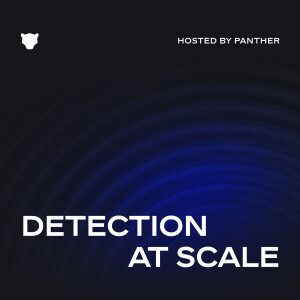
Wednesday Nov 27, 2024
Outreach’s Brandon Kovitz on Balancing Human Intuition and AI in Cyber Defense
Wednesday Nov 27, 2024
Wednesday Nov 27, 2024
In this episode of Detection at Scale, Jack speaks to Brandon Kovitz, Senior Manager of Detection & Response at Outreach, shares his insights on the evolving landscape of cybersecurity. He discusses the critical role of generative AI in enhancing detection and response capabilities, emphasizing the importance of understanding data to maximize security tools' effectiveness.
Brandon also highlights the balance between human intuition and AI, noting that while AI can analyze vast amounts of data, it lacks the nuanced understanding of intent that only humans can provide. Tune in to learn how organizations can leverage AI while maintaining essential human oversight in their security strategies!
Topics discussed:
- The importance of operationalizing detection and response capabilities to enhance security posture in a cloud-native, SaaS-first environment.
- Leveraging generative AI to improve data analysis and streamline detection processes, ultimately enabling faster responses to emerging cyber threats.
- The critical balance between AI capabilities and human intuition, emphasizing that human expertise is essential for understanding intent behind actions in cybersecurity.
- Understanding the data landscape is vital for maximizing the effectiveness of security tools and ensuring a strong return on investment.
- The role of automation in reducing the noise from tier one and tier two security alerts, allowing teams to focus on complex issues.
- Insights on building a detection-as-code pipeline to facilitate rapid implementation of security measures in response to emerging vulnerabilities.
- The significance of collaboration between security teams and privacy experts to ensure compliance and protect customer data in AI initiatives.
- The future of cybersecurity operations, including the potential for AI to automate many routine tasks and enhance overall operational efficiency.
- The necessity for ongoing education and adaptation in the cybersecurity field to keep pace with technological advancements and evolving threats.
Resources Mentioned:

Wednesday Nov 13, 2024
Rootly’s JJ Tang on Transforming Incident Management Culture
Wednesday Nov 13, 2024
Wednesday Nov 13, 2024
In this episode of Detection at Scale, Jack speaks to JJ Tang, CEO and Co-founder of Rootly, about revolutionizing incident management in tech organizations. JJ shares his journey from practitioner to founder and emphasizes the importance of viewing incident management as a cultural and collaborative effort rather than just a tooling issue.
JJ touches on breaking down silos between security and other teams to enhance communication and reliability, and empowering security practitioners to take on educator roles within their organizations. He also offers actionable insights on creating a culture of reliability and improving incident response strategies!
Topics discussed:
- The importance of viewing incident management as a cultural shift rather than just a tooling problem, focusing on people and processes.
- Strategies for breaking down silos between security teams and other departments to foster collaboration and improve incident response effectiveness.
- The role of security practitioners as educators, helping other teams understand best practices and the importance of security in incident management.
- The significance of collecting and analyzing data on repeat incidents to identify root causes and prevent future occurrences.
- Insights on how to create a culture of reliability within organizations, making incident management a shared responsibility across teams.
- The challenges faced during the transition from a practitioner role to a founder and CEO in the tech industry.
- The impact of AI and automation on incident management, including how these technologies can improve response times and learning from incidents.
- The necessity of having a clear governance framework in place to ensure data privacy and security during incident management processes.
Resources Mentioned:
